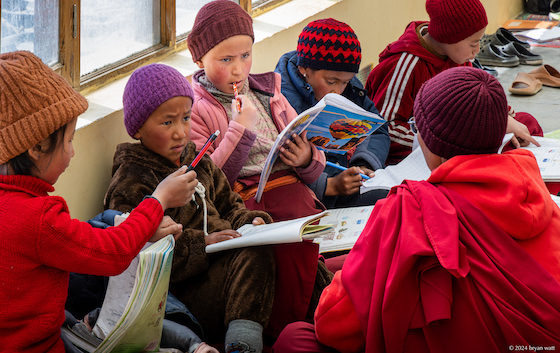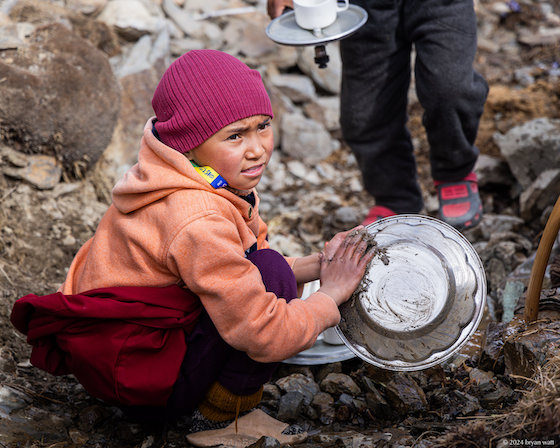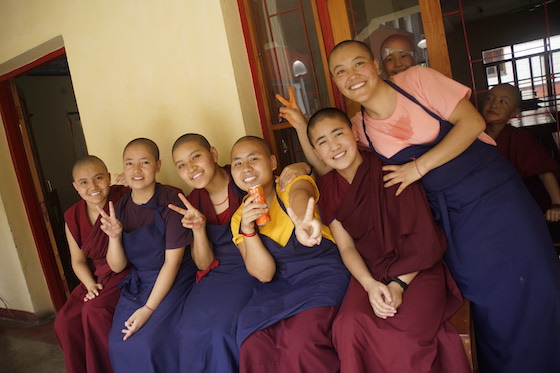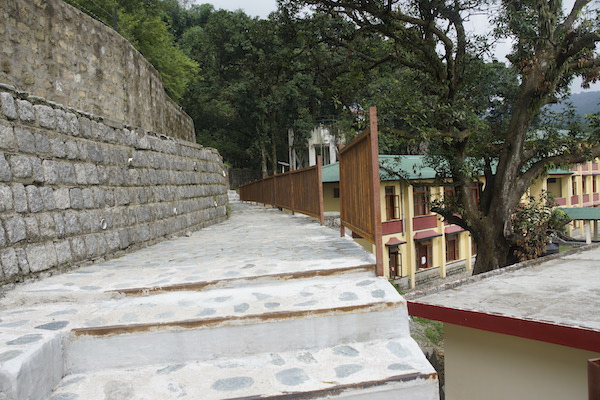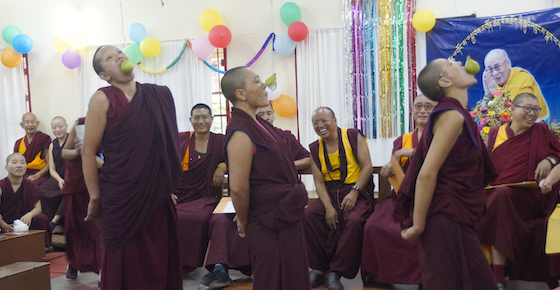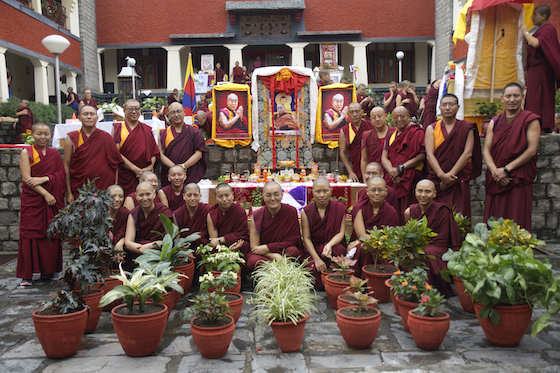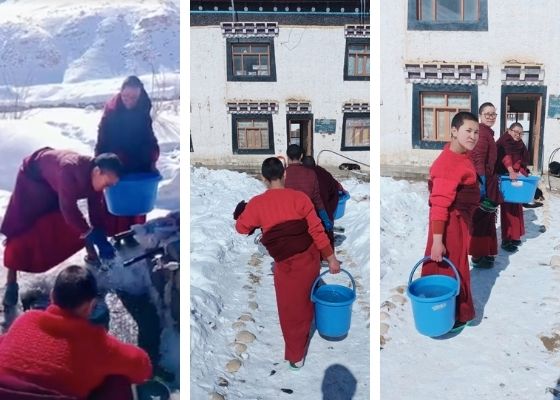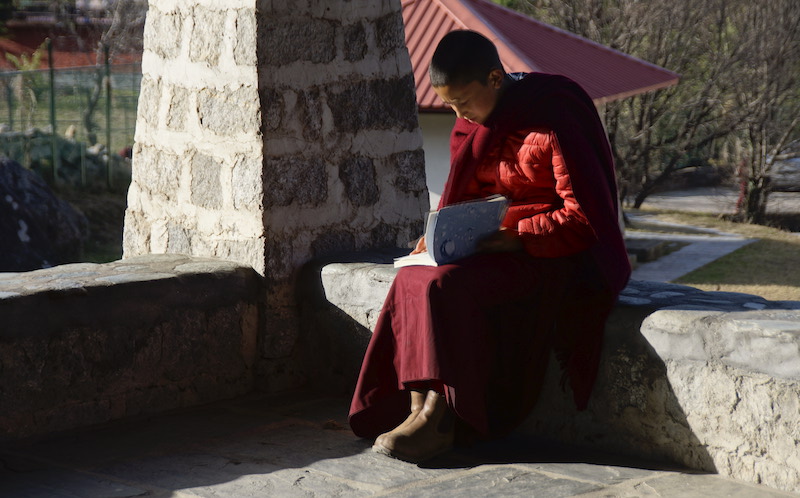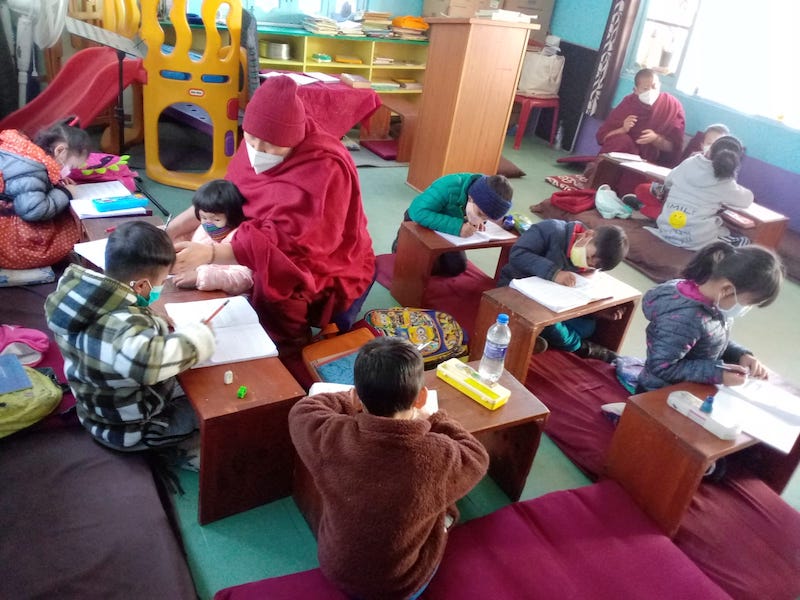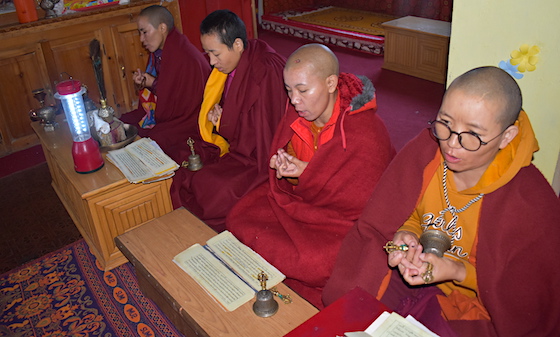The Tibetan Nuns Project was created in response to a huge influx of nuns who arrived in India after escaping from Tibet. Finding shelter and creating long-term housing for the nuns was an urgent task.
Unlike monks who escaped and who had the option of joining established monasteries in India, there were no nunneries to go to for the nuns arriving in India. The two nunneries, Geden Choeling and Tilokpur, in and around Dharamsala, the home in exile of His Holiness the Dalai Lama and the destination of choice for most Tibetan refugees, were both crowded and struggling.

This archival photo shows one of the many exiled Tibetan nuns living in tents in India.
Housing for nuns in the early days
“We had a huge influx of nuns from Tibet after 1987 — nuns who had been to prison and tortured,” says Rinchen Khando Choegyal, Founding Director and Special Advisor to the Tibetan Nuns Project.
“Many had had to leave their nunneries in Tibet because they had been on demonstrations. Because of that, they were imprisoned and not allowed to go back to their nunneries. The only option for them was to escape and come to India via Nepal. This was one of the very pressing reasons for the Tibetan Nuns Project to come into existence — so that we could shelter and look after these nuns, and so they could have an education.”

Nuns studying inside one of the rented houses before the Tibetan Nuns Project built two new nunneries.
“All these nuns arrived from Tibet with nothing, in bad health, 99% not knowing how to read and write, traumatized in the prisons, beaten by the prison guards, with damaged kidneys and all kinds of health problems. And here we were trying to set up nunneries and a system of education for them… It was amazing how our international friends came forward to help us financially,” says Rinchen Khando Choegyal.

2025 marks the 15th anniversary of the inauguration of Shugsep Nunnery and Institute, now home to about 100 nuns. The original rented house is on the left.
In the early days, the Tibetan Nuns Project rented four houses in Dharamsala to accommodate the newly arrived nuns.
Dr. Elizabeth (Betsy) Napper, US Founder and Board Chair of the Tibetan Nuns Project, describes the housing situation in the late 1980s and 1990s:
“The Dolma Ling nuns were housed in a very dark, rented house with bunk beds three high — 18 in a room. They cooked outside in an outer cooking area with a canopy over it.”

In the early days, before the Tibetan Nuns Project built Dolma Ling and Shugsep nunneries, the nuns cooked outdoors in temporary structures.
“The situation for the Shugsep nuns wasn’t much better. We were able to move the Dolma Ling nuns down to a rented house and give the Shugsep nuns the small house that they had been in. It, too, was way too small. Every available space was filled by a bed; even under the stairs there were beds.”
“The structure was poorly built, and rain would run down the walls during the monsoon. It was damp and moldy in there. It was awful.”

On the left, a nun holds a paper model of Dolma Ling. 2025 marks the 20th anniversary of the inauguration of Dolma Ling on December 8, 2005 by His Holiness the Dalai Lama. The nunnery took 12 years to build. Our current project is to build suitable accommodation for elder nuns.
“Bit by bit, we built things, like a bathroom toilet block. Every bit of it was a struggle. But more nuns kept coming. Every time we thought we had the space OK, more nuns would come, so it would get overcrowded again. That was why we had to build a whole new nunnery. Both nunneries — Dolma Ling and Shugsep — started out in really overcrowded, substandard housing.”
Construction of the new Shugsep Nunnery in India began in January 2006. The nuns lived for ten years in damp, crowded conditions while the nunnery was being built.

While they were living in rented housing, the nuns helped build the new nunneries. This archival photo by Jessica Tampas shows nuns working to build Dolma Ling Nunnery. The nunnery took 12 years to build and was officially inaugurated by His Holiness the Dalai Lama on December 8, 2005. It is now home to about 300 nuns.
Housing Now
Betsy Napper describes the current housing situation for the nuns at Dolma Ling and Shugsep nunneries.
“The housing is still simple and basic. The standard configuration is two nuns to a room. Each nun has a bed, a table, a bench, a little storage area where she can put her books for study and practice, and a little area where she can set up an altar. Only nuns who are very senior or who have special responsibilities get single rooms.”

Inside a nun’s room at Dolma Ling Nunnery. The accommodation is basic, with simple furniture, shared rooms, and no heat. In the winter, the temperature drops to 50 degrees Fahrenheit or 10 degrees Celsius. Photo courtesy of Brian Harris.
“Of course there’s no way at all to afford heating. Heating is impossible. None of the nunneries are heated. In the winter, the nuns will try to sit outside in the sun because the buildings are cold.”

Making a dream come true. Thanks to supporters around the world, the Tibetan Nuns Project was able to build two large nunneries and also support 5 more. This archival photo shows a holding a model of Dolma Ling Nunnery in front of the construction site in the early days of its 12-year construction.
“Hot water has always been a struggle. We were able to put in solar hot water and make bath houses for both Dolma Ling Nunnery and Shugsep Nunnery so that the nuns have an option of bathing with hot water. We also got hot water into the kitchens, using solar panels at both nunneries.”
The Pressing Need For Elder Housing
The Tibetan Nuns Project was founded almost 40 years ago in 1987. The nuns are aging, some are ill, and they need suitable accommodation. The nuns at Dolma Ling need your help to build 20 double rooms to house 40 elder nuns in a purpose-built two-story building. The aim is to create a comfortable living space for older nuns while fostering their sense of community and caring for each other.

Ani Rigzen, aged 74, is one of the elder nuns at Dolma Ling, carrying with her years of quiet devotion and peace. Please help us build 20 double rooms for elder nuns at Dolma Ling.
This special building will:
∗ Be wheelchair accessible on the ground floor
∗ Have low-rise stairs for those who have difficulty climbing stairs
∗ Have slightly larger rooms than the regular dormitory rooms
∗ Have a private bathroom for each room with handrails and a Western-style toilet
∗ Have a small kitchenette in each room
∗ Be equipped with an alarm bell system for vulnerable nuns

It is very difficult for elder nuns to use Indian-style squat toilets. They try to use them now with the aid of potty seats for support, but access to Western-style toilets would greatly ease their daily lives.
Please help provide elder housing for the nuns. Learn more and donate here.





